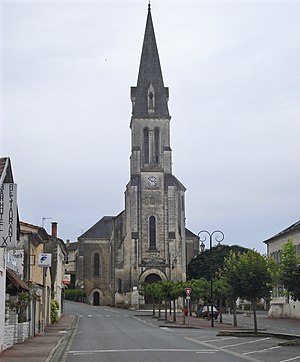Mussidan
| Mussidan | ||
|---|---|---|

|
|
|
| region | Nouvelle-Aquitaine | |
| Department | Dordogne | |
| Arrondissement | Périgueux | |
| Canton | Vallée de l'Isle | |
| Community association | Isle et Crempse en Périgord | |
| Coordinates | 45 ° 2 ′ N , 0 ° 22 ′ E | |
| height | 42-106 m | |
| surface | 3.85 km 2 | |
| Residents | 2,710 (January 1, 2017) | |
| Population density | 704 inhabitants / km 2 | |
| Post Code | 24400 | |
| INSEE code | 24299 | |
| Website | http://www.mussidan.fr/ | |
 St. George Church |
||
Mussidan ( Occitan : Moissida ) is a municipality in the French region of New Aquitaine with 2710 inhabitants (January 1, 2017). It is located in the Dordogne department .
geography
The municipality is located in the Périgord Blanc (white Périgord) on the left bank of the Isle , where the Crempse flows into the river.
With an area of less than four square kilometers, it is one of the smallest municipalities in the department.
City district (Quartiers)
In the town center:
- Quartier de la Halle
- Quartier de la Gare
On the outskirts:
- Seguinou district
- Beaupuy district
- La Clède district
- La Freunie district
history
The city is first mentioned in the essays by Montaigne in 1569. The spelling Mucidan can be found on the Cassini map , which was created as part of the first more precise survey of France between 1756 and 1789. A first wooden bridge crossing the Isle is documented in 1840.
On June 11, 1944, a group of the SS fusilized 52 people in Mussidan in retaliation for an attempted sabotage of the railway by the Resistance , including Raoul Grassin, mayor of the city. Also involved in the massacre was the so-called "SS Mohamed" , a brigade of French people who were born in North Africa and who collaborated with the German occupiers , led by Alexandre Villaplane .
In the 1950s, Mussidan was an important industrial center in the Dordogne. After a period of crisis, Mussidan is now enjoying a boom thanks to the A89 autoroute , the exit of which is three miles south of downtown.
Population development
| year | 1962 | 1968 | 1975 | 1982 | 1990 | 1999 | 2006 | 2016 |
| Residents | 3024 | 3048 | 3235 | 53236 | 2985 | 2843 | 2831 | 2728 |
| Sources: Cassini and INSEE | ||||||||
Attractions
- Musée des Arts et Traditions Populaires du Périgord du Docteur Voulgre (Museum of Popular Arts and Traditions of the Périgord). The museum comes from the legacy of Dr. André Voulgre for his hometown Mussidan. The doctor moved to Bordeaux, where he founded an institute for physiotherapy and physical education. He remained fully connected to the Périgord and spent his whole life in his father's house in Mussidan. His collection recalls the past and the evolution of Périgord society through literature, art, everyday life, technological developments, etc. On the eve of his death in 1971, he bequeathed his “Chartreuse” and his collections to his hometown, provided that all the name “Musée des Arts et Traditions Populaires du Périgord du Docteur Voulgre”. The city accepted the donation and an association of "Friends of the Museum" was created in 1973 to promote the work of Dr. Voulgre continues to nurture and enrich.
- Neo-Romanesque Saint Georges church from the 19th century, built by the architect Abadie .
- Old Notre-Dame du Roc church, 16th to 17th centuries. Converted into a cinema.
Personalities
- Nicolas Beaupuy (1750–1802), military and politician
- Michel de Beaupuy (1755–1796), General of the French Revolution
- Guillaume-Joseph Chaminade (1761–1850), clergyman and founder of the order, pupil, later professor at the collège de Mussidan from 1771 to 1791
- Madeleine Delbrêl (1904–1964), writer and Catholic mystic
- Antoine Duranthon (1736–1793), French minister
- Louis Philippe Maine (1830-1893), military
- John Misaubin (1673–1734), 18th century medic
- Isaac Schneersohn (1879 or 1881–1969), founder of the Center de Documentation Juive Contemporaine ( CDJC )
- Émile Bazillou, Resistance fighter, murdered by the Nazis
Twin cities
- Woodbridge (Suffolk) , East Anglia , England (since 1973)
- Sainte-Anne in Martinique (since 1988)
- Vigy , Lorraine (since 1991)
Web links
Individual evidence
- ^ Article in the Journal Sud Ouest, Périgueux edition, June 16, 2009
- ↑ Marcel Dreykopf: Soccer. The very last. Intrigue and stupidity from the world of football (= Rororo 62679 non-fiction book ). Completely revised new edition. Rowohlt-Taschenbuch-Verlag, Reinbek bei Hamburg 2011, ISBN 978-3-499-62679-1 , p. 208.
- ↑ Site du Musée
- ↑ Joseph Simler: Guillaume-Joseph Chaminade. Chanoine Honoraire de Bordeaux, Fondateur de la Société de Marie et de l'Institut des Filles de Marie (1761–1850). V. Lecoffre et al., Paris et al. 1901, pp. 10-40, ( digitized version ).



